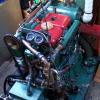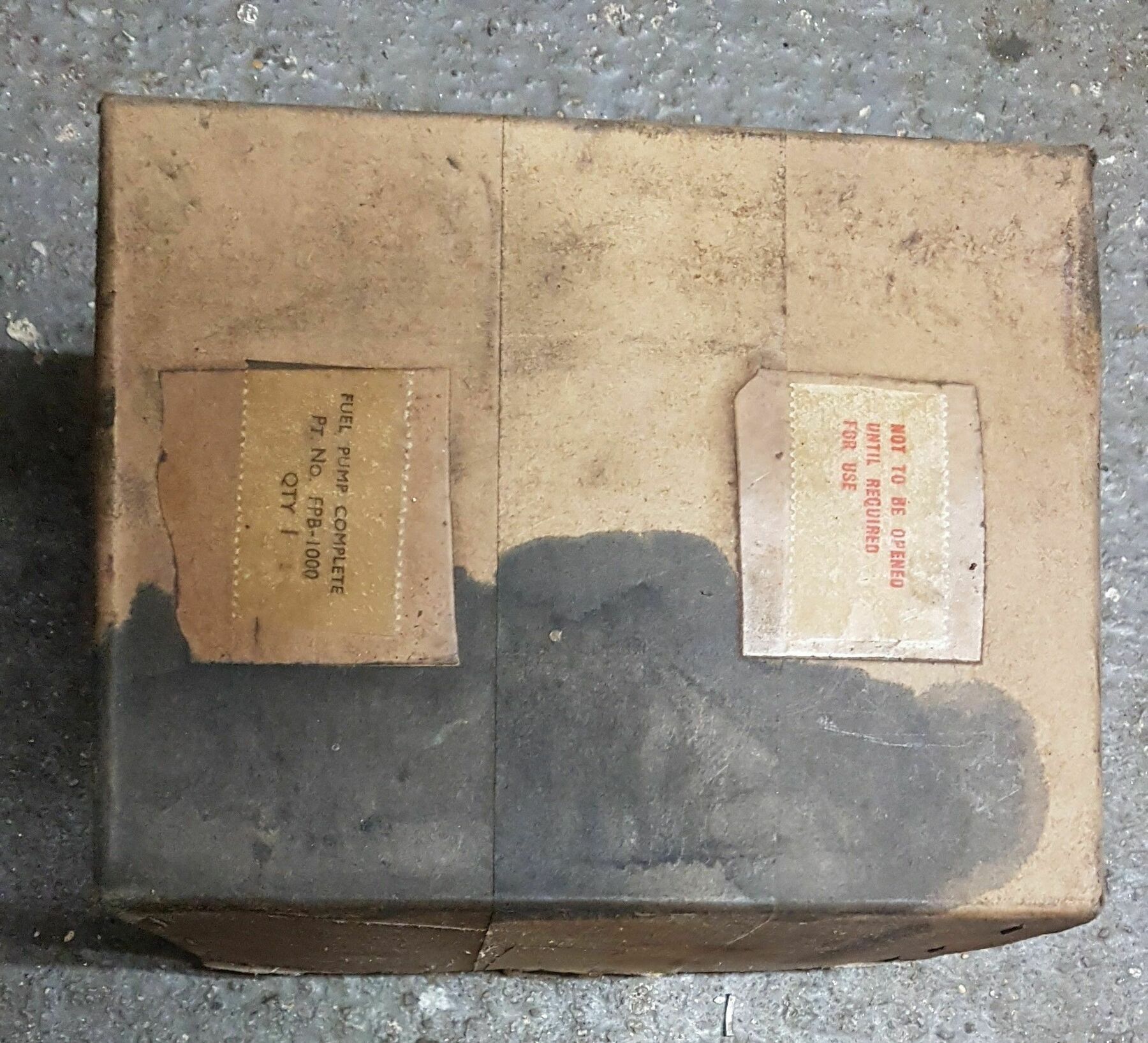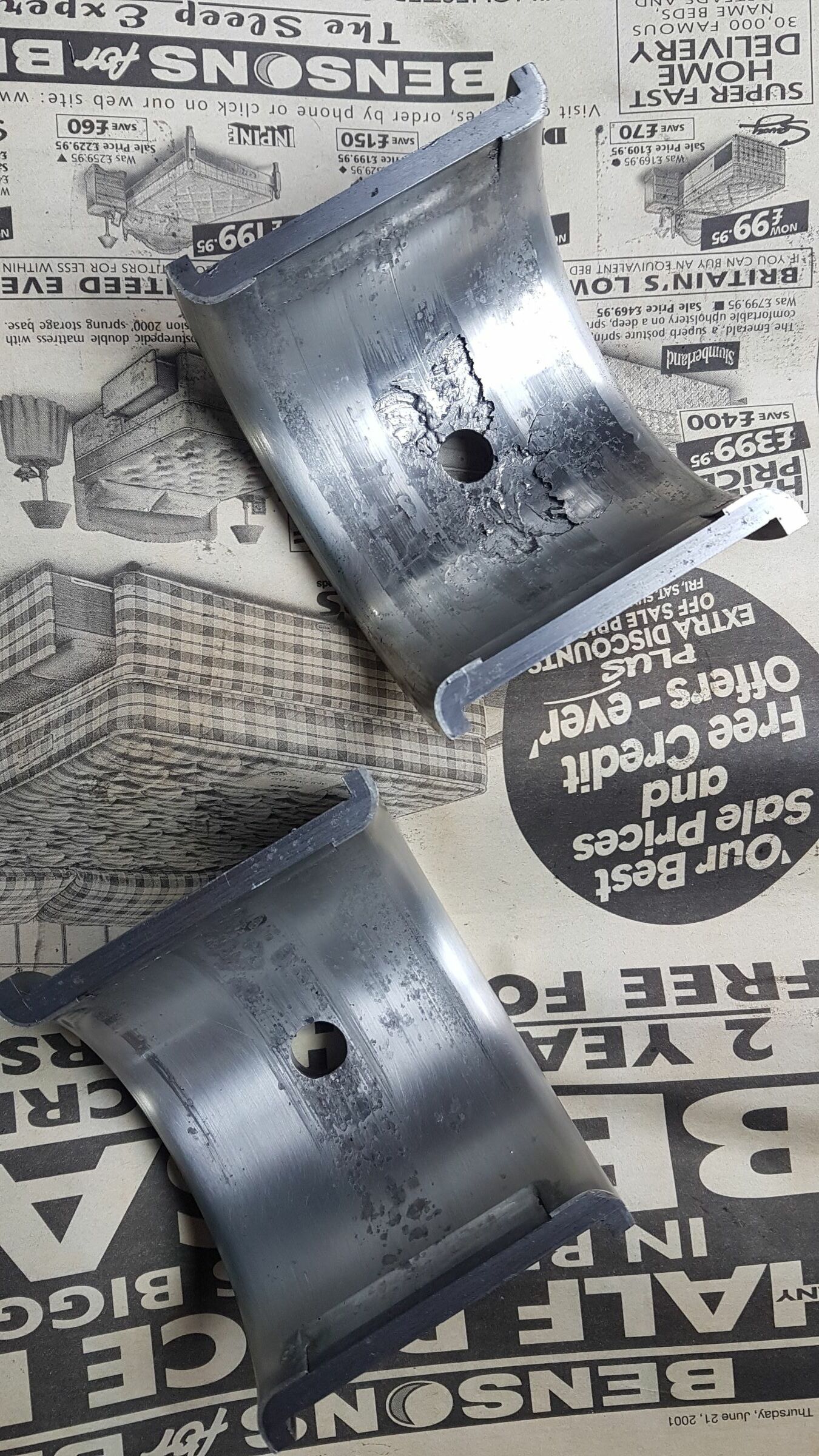-
Posts
53 -
Joined
-
Last visited
Content Type
Profiles
Forums
Events
Gallery
Blogs
Store
Everything posted by tommylad
-
Hi, I have a Lincoln Ruston & Hornsby 2 VSH for sale. It was purchased around 40 years ago and came from a crane. It appears to have been sadly neglected when we bought it, as the bottom end was full of sludge. The rocker box has been smashed where someone ripped off the brass plaque. This could be patched over and used again. One of the lifting eyes has also been broken. I've not had the engine running, but I have had the head off. This is now refitted. The engine comes with fuel pumps and injectors, starting handle, thermostat housing, fuel filter body, and starter motor clamp. It is on a makeshift trolley. It is available for collection from DE24 5AE. You will need your own lifting gear unfortunately as I don't have suitable lifting gear. Price £150
-
Hi, I have 1 off, boxed, genuine Ruston & Hornsby fuel injector for the VSH engine for sale. Part number: VSH-111E. The box is opened, but the injector is still in its protective wax coating and wrapped in oiled paper. The box states 'Aug 1952' on it. This was purchased with a 2VSH around 40 years ago and has been dry stored since. Price £300. I can post or collection from DE24 5AE is welcome.
-
Hi, I have 2 off, boxed genuine Ruston & Hornsby fuel injection pumps for the VSH engine for sale, Part number on packaging: FPB-1000. Part number on pumps: FPBA1000B The boxes are opened, but the parts are still in their protective wax coating and wrapped in oiled paper. One of the boxes states '1952' and the two boxes are identical. These were purchased with a 2VSH around 40 years ago and have been dry stored since. Price £500 each. I can post or collection from DE24 5AE is welcome.
-
Yes, all sounds familiar! And yes, it's just not funny how annoying it is!!
-
It's a marine auxiliary engine (1962) - came from an isle of mann ferry (was used for pumping water for washing the decks), so dry sump, water cooled silencer, even lloyds stamped, but with the industrial crank and no gearbox. Odd to think it's been in the narrowboat for longer than it was in the ferry! Interesting comment. Are we perhaps causing damage to our irreplaceable pumps/injectors by running modern fuels in them? Has anyone else got experience/knowledge of additives which might help?
-
Just thought I'd share my experiences of finally sorting the hunting problem my engine has suffered from when hot at idle. It used to idle beautifully around 30 years ago, but gradually started hunting as the years have gone by. I gather this is a problem for quite a few JPs - and I know some on this forum have given very useful advice on it. I'd always assumed it was because of worn bearings in the governor, so when I rebuilt it 3 years back I was surprised to find the governor in spot-on condition. I did replace the tension spring and clean out & re-lube the bearings on the bell crank, but surprise surprise when the job was finished the hunting was still present. More recently, I've checked some of the setup of my fuel pump, and whilst in there, decided to oil some moving parts which I understood should be lubricated by diesel, but I thought why not? As I oiled the rack and plungers, I noticed that the movement of the rack did free up a little, and to my great delight I've found that the hunting is now gone! I'm so pleased to have my metronomic grand father clock back at last!! I'd encourage anyone with the same issue to not fear going into the pump to try this fix, as it's very easy. I'd always been reticent to open up the pump but if you're careful with cleanliness then you really shouldn't fear taking the inspection cover off the side of the pump and squirting a bit of oil around in there. I used 20 grade mineral oil. If you have a very compact screwdriver the cover can probably be taken off with the pump in situ, but I removed my pump to do the other checks, which does make access easier.
-
I'd try and avoid any disassembly to start with, just oil the threads which are exposed when they're screwed out. If they're coked up it might be an idea to wire brush them before oiling. Mine is smokier on low compression when on light load too.
-
Sounds likely that it's carbon build up. They do need screwing in quite tightly even when clean & oiled (both hands). You could try oiling the threads and giving them some 'exercise' which should sort it I'd expect. If it comes to it, removing them just needs a big adjustable in my experience
-
I think this could well be the candidate for the oil in the exhaust. In my experience by the time the oil can overflow down the push rod tubes it's already above the valve guides, so oil can track down the exhaust valve stem and then onwards to your hair/clothes/wine glass etc 😛 If you've already reduced oiling to a minimum it might be worth waiting a while to see if this fixes the problem
-
Impressive that the as-cast surface is that good, both wrt surface finish and geometrical accuracy
-
Ah I see - sounds obvious when you explain it! Interesting how one CNC machine can do the work of so many customized ones
-
No, I guess you really need a CMM for properly checking it Yes, I'm baffled as to how they machined pistons before CNC machines?
-
Many thanks for this BEngo - I did check and had (and still have) the 2 thou nip stated in the manual. Would be good to have cylindricity checked wouldn't it - although I guess it must be very close anyway else the bearing would've been tight when fitted.
-
Yes thanks! Lots of lovely engines lying around! I particularly liked the NEW 6 cyl Riley blocks they're machining up! I've left the big end with them - Martin was very relaxed about the job, apparently the smaller the bearing the harder it is to remetal, so a JP one should be a doddle! Many thanks BEngo, but as above I've taken it to CCE, Cheers, Tom
-
Cheers Richard, I'll give them a try too
-
Yes, I think that could be the best option for a more long term solution. When I rebuilt it I was only able to find one NOS big end bearing, which is still fine - but the repro one is really dissapointing. I guess these parts are principally intended for engines which run at the occaisional steam rally, not clocking up proper hours under load in a boat! Coventry boring remetalled my main bearings and although not cheap I was really pleased with the work they did - I'll give them a call.
-
I've just noticed the dreaded white metal in my oil tank filters and on further inspection I've found that the repro big end shells I fitted only 500 hours ago have given up the ghost They weren't tight when fitted, lubrication is good and it hasn't been knocking, so my only thought is that it's a quality issue with the shells. Any chance someone has a pair (for one big end) of undersize shells they'd be willing to sell? I need 10 thou undersize or smaller such that I can get them machined out - thank you!!
-

WANTED: Vanette GG2200 Oven shelf
tommylad replied to tommylad's topic in Boat Building & Maintenance
Not exactly a punctual response, but thank you! Midland Chandlers were able to sort me out with one from a more recent oven which was a perfect fit! -
As per title, I managed to lose my oven shelf overboard yesterday (don't ask) so it's now 10' under in the middle of the Trent! After some time fishing for it with the magnet I had to give best so I'm on the lookout for a replacement! Cheers, Tom
-
Apologies for dragging this thread away from hot bulbs... https://www.ebay.co.uk/itm/Ruston-Hornsby-Canal-Boat-Marine-Engine/174248574590?_trkparms=aid%3D111001%26algo%3DREC.SEED%26ao%3D1%26asc%3D20160908105057%26meid%3D9fb6bfe7f7f9402c93335a2a639cd53c%26pid%3D100675%26rk%3D3%26rkt%3D15%26mehot%3Dnone%26sd%3D324131068819%26itm%3D174248574590%26pmt%3D0%26noa%3D1%26pg%3D2380057&_trksid=p2380057.c100675.m4236&_trkparms=pageci%3Ad772922a-7ee2-11ea-b070-74dbd1809f93|parentrq%3A7c89b9c41710aa47af42f5a3ffe2bb78|iid%3A1
-

Making a rev counter - how hard can it be?!
tommylad replied to tommylad's topic in Vintage Engine Forum
Dave, Sorry, I wasn't very clear in what I said. What I was proposing was to give up on the old tacho, and simply buy a new one, repaint its face and re-calibrate. This has the benefit of being quite straightforward, and giving me the ideal rev range, however, loses the character of the old instrument. I'm quite comfortable with programming though, I've done a bit in VBA and arduino code looks not too different to this, and I'm quite competent at basic soldering etc. I'm just not sure how big a project I want to make of this! I've managed for 30 years without a rev counter so it's definitely in the 'nice to have' category! -

Making a rev counter - how hard can it be?!
tommylad replied to tommylad's topic in Vintage Engine Forum
Lots to consider here. Yes, my thinking was to gut the existing tacho and basically only keep the housing, face and needle, which would be driven by the movement from an electronic tacho. DMR - you've raised a very good point about starting from 250 - that may well be an issue. Perhaps the arduino idea could resolve this, although it sounds like a bit of a can of worms! Tacet, a motor drive is an idea, although I'm not sure it would be any simpler, and I'm not convinced how linear such a system would be? And jake_crew, I completely take your point about ruining an old instrument, however, I can't think of an application for this now? I assume it would've come off some form of stationary engine. To modify it for use on a boat surely can't be that bad?! (it beats sitting in a field at steam rallies :-P) That said, I think the modification may just prove to be too difficult... I'm now moving towards perhaps still buying this https://www.interparts.uk/1224v-alternator-pick-up-tachometer---0-8000rpm-0-523-80-7314-p.asp?gclid=Cj0KCQjwjoH0BRD6ARIsAEWO9DtSmZFK_S817wbf8T0mHfa2QzVmw2uluzyn2P6K8YP2mDAjNQ4XPMgaAiTfEALw_wcB or the ISSPRO but asking a local instrument restorer to repaint the face such that it goes from 0-1200 rpm which is the correct range for my JP (although I never take it above 900 anyway). I'll then be able to calibrate it quite easily. Many thanks for the tips! -

Making a rev counter - how hard can it be?!
tommylad replied to tommylad's topic in Vintage Engine Forum
https://www.interparts.uk/1224v-alternator-pick-up-tachometer---0-8000rpm-0-523-80-7314-p.asp?gclid=Cj0KCQjwjoH0BRD6ARIsAEWO9DtSmZFK_S817wbf8T0mHfa2QzVmw2uluzyn2P6K8YP2mDAjNQ4XPMgaAiTfEALw_wcB This might be just the ticket..... -

Making a rev counter - how hard can it be?!
tommylad replied to tommylad's topic in Vintage Engine Forum
I did wonder about this, but the pulley is the wrong orientation (the gauge would end up facing sideways!) and I'm not keen on a mechanical drive system which would need maintenance, a shroud for safety and also limit installation positions. As it happens, I'd also struggle to get a belt drive off my engine for it! -
OK, got a challenge for all you bored people in lockdown atm! I have this rev counter which is intended to be belt driven. I really like the idea of fitting new internals such that I can retain the clock face and needle, but drive it off the W post of my alternator. I'm confident enough of being able to do the mechanical side of this job, but I would appreciate if anyone can advise if it's possible to buy a rev counter that can be 'calibrated' to display the correct engine speed on this face? My alternator will be doing 7 353 rpm when the engine is at 1 000 rpm. Thanks!

















.jpg.9e85fd009426e76d57753dd08eb91edd.jpg)
